Experimental Measurements of a Joint 5G-VLC Communication for Future Vehicular Networks
Abstract
1. Introduction
2. VLC-5G Integration System Model
3. 5G Field Trials
3.1. Field-Trials Organization
- (1)
- Set-up phase: The ZTE Research and Innovation Lab has investigated and tested new 5G technologies.
- (2)
- Roll-out phase: Several NR base stations (BSs) have been deployed to test all network elements and basic network functions. Initially, the deployment relays on the existing LTE-Core Network (CN) following the NSA network architecture. At the end of the project the SA network architecture (with a 5G-CN) will be deployed and evaluated.
- (3)
- Service phase: Extensive field trials to validate the KPIs and to test innovative services provided on the 5G network infrastructure.
3.2. 5G Network
3.2.1. Network Architecture
3.2.2. Physical Infrastructure
- Operations in multiple frequency bands;
- Massive MIMO (mMIMO) techniques;
- Non-orthogonal multiple access (NOMA);
- Dense network deployment.
3.3. Use Cases
Smart Mobility Use Case
- (1)
- Road monitoring: electric parking and charging points are being deployed for the purpose of monitoring the state of the road surface (presence of gaps, slope, traffic conditions, etc.) during regular everyday activities by installing in the vehicles a blackbox containing a 5G module for real-time transmission of information to a data processing center. Electric cars are equipped with a differential GPS that can map the geographic positions of the holes found during regular vehicle use with a precision of cm.
- (2)
- Advanced viability: vehicles share data with other vehicles and with a control center where data traffic information is smartly combined other information such as the city’s temperature, the road status and other sensors information. The goal is to use real-time information for increasing car and driver health, comfort, and style of driving and for minimizing road traffic, congestion, and consequent emissions.
- (a)
- Network Slicing: The 5G network is able to provide specific network slice for V2X communications in order to manage its own features independently on the other services. However, how slices can efficiently share the resources is still a challenging issue. The studying of practical algorithms is ongoing considering both the computational complexity and the ability to reconfigure the resources allocation following the variability of the vehicular network topology. In particular, one of the main challenges of the infrastructure layer is the virtualization and division of the RAN into slices due to spectrum limitation. In addition, the coexistence communications with the network (V2N) and among vehicles requires a high flexibility and dynamicity of the RAN.
- (b)
- MEC: Reduced network congestion and improved applications performance can be obtained by using the multi-access edge computing (MEC) paradigm, which introduces cloud-computing capabilities closer to the end-user within the access network. Data generated from vehicles and infrastructure can be efficiently processed by the MEC thus delivering locally-relevant contents to support smart driving services. The MEC allows ultra-low latency, high bandwidth and real-time access to the access network that can be leveraged by the applications.
- (c)
- Access point densification: Network capacity can be improved by deploying a large number of small cells in addition to traditional macrocells. Moreover, in case of emergency or network unavailability, vehicles themselves could complement the public network becoming moving cells. Anyway, in case of coexistence of multiple cell-layers, a careful investigation on resource usage is required as well as on coordination strategies among all the cells.
- (d)
- Multi RATs: In the smart mobility paradigm, multiple radio access technologies (Multi-RAT) can be integrated into vehicles, which become a powerful mobile gateway. Both V2V and V2N communications (e.g., 802.11p, LTE, C-V2X, 5G, VLC) could ask for multi-RATs integration, although an accurate managing should be done for the exploitation of benefits and limitation of their drawbacks.
4. VLC for Vehicular Services
5. Advanced Viability Experimental Activity
5.1. Test-Bed Description
- Flame sensor: To simulate a fire alarm.
- Gyroscope/accelerometer: To detect an incident between to (scale model) cars.
- Temperature, humidity and pressure sensors: To detect the presence of ice on the road.
5.2. Experimental Results
6. Conclusions
Author Contributions
Funding
Acknowledgments
Conflicts of Interest
References
- Feng, L.; Hu, R.Q.; Wang, J.; Xu, P.; Qian, Y. Applying VLC in 5G Networks: Architectures and Key Technologies. IEEE Netw. 2016, 30, 77–83. [Google Scholar] [CrossRef]
- IEEE. IEEE Standard for Local and metropolitan area networks—Part 15.7: Short-Range Optical Wireless Communications. In IEEE Std 802.15.7-2018 (Revision of IEEE Std. 802.15.7-2011); Institute of Electrical and Electronics Engineers (IEEE): New York, NY, USA, 2019; pp. 1–407. [Google Scholar]
- Rahaim, M.B.; Little, T.D.C. Toward practical integration of dual-use VLC within 5G networks. IEEE Wirel. Commun. 2015, 22, 97–103. [Google Scholar] [CrossRef]
- Ulgen, O.; Ozmat, U.; Gunaydin, E. Hybrid Implementation of Millimeter Wave and Visible Light Communications for 5G Networks. In Proceedings of the 2018 26th Telecommunications Forum (TELFOR), Belgrade, Serbia, 20–21 November 2018; pp. 1–4. [Google Scholar]
- Wu, S.; Wang, H.; Youn, C.-H. Visible light communications for 5G wireless networking systems: From fixed to mobile communications. IEEE Netw. 2014, 28, 41–45. [Google Scholar] [CrossRef]
- Haas, H.; Cheng, C. Visible Light Communication in 5G. In Key Technologies for 5G Wireless Systems; Cambridge University Press: Cambridge, UK, 2017. [Google Scholar]
- Haas, H. LiFi is a paradigm-shifting 5G technology. Rev. Phys. 2018, 3, 26–31. [Google Scholar] [CrossRef]
- Shafi, M.; Molisch, A.F.; Smith, P.J.; Haustein, T.; Zhu, P.; De Silva, P.; Tufvesson, F.; Benjebbour, A.; Wunder, G. 5G: A Tutorial Overview of Standards, Trials, Challenges, Deployment, and Practice. IEEE J. Sel. Areas Commun. 2017, 35, 1201–1221. [Google Scholar] [CrossRef]
- Ptzold, M. 5G developments are in full swing [mobile radio]. IEEE Veh. Technol. Mag. 2017, 12, 4–12. [Google Scholar] [CrossRef]
- Shi, L.; Li, W.; Zhang, X.; Zhang, Y.; Chen, G.; Vladimirescu, A. Experimental 5G New Radio integration with VLC. In Proceedings of the 2018 25th IEEE International Conference on Electronics, Circuits and Systems (ICECS), Bordeaux, France, 9–12 December 2018; pp. 61–64. [Google Scholar]
- Tsiropoulou, E.; Gialagkolidis, I.; Vamvakas, P.; Papavassiliou, S.; Mitton, N.; Loscrí, V.; Mouradian, A. Resource Allocation in Visible Light Communication Networks: NOMA vs OFDMA Transmission Techniques. In Computer Vision; Mitton, N., Loscri, V., Mouradian, A., Eds.; Springer: Berlin/Heidelberg, Germany, 2016; Volume 9724, pp. 32–46. [Google Scholar]
- Marabissi, D.; Mucchi, L.; Fantacci, R.; Spada, M.R.; Massimiani, F.; Fratini, A.; Cau, G.; Yunpeng, J.; Fedele, L. A Real Case of Implementation of the Future 5G City. Future Internet 2018, 11, 4. [Google Scholar] [CrossRef]
- Nizzi, F.; Nawaz, T.; Catani, J.; Seminara, M.; Pecorella, T.; Caputo, S.; Mucchi, L.; Fantacci, R.; Bastianini, M.; Cerboni, C.; et al. Data dissemination to vehicles using 5G and VLC for Smart Cities. In Proceedings of the 2019 AEIT International Annual Conference (AEIT), Florence, Italy, 18–20 September 2019. [Google Scholar]
- Tsiropoulou, E.; Vamvakas, P.; Papavassiliou, S.; Singhal, C.; De, S.; Xu, X. Resource Allocation in Multi-Tier Femtocell and Visible-Light Heterogeneous Wireless Networks. In Advances in Wireless Technologies and Telecommunication; IGI Global: Hershey, PA, USA, 2017; pp. 210–246. [Google Scholar]
- Ordonez-Lucena, J.; Ameigeiras, P.; Lopez, D.; Ramos-Munoz, J.J.; Lorca, J.; Folgueira, J. Network Slicing for 5G with SDN/NFV: Concepts, Architectures, and Challenges. IEEE Commun. Mag. 2017, 55, 80–87. [Google Scholar] [CrossRef]
- De La Oliva, A.; Hernandez, J.A.; Larrabeiti, D.; Azcorra, A. An overview of the CPRI specification and its application to C-RAN-based LTE scenarios. IEEE Commun. Mag. 2016, 54, 152–159. [Google Scholar] [CrossRef]
- 3rd Generation Partnership Project. TR 23.799 Technical Specification Group Services and System Aspects. In Study on Architecture for Next Generation System Tech. Rep. V14.0.0, Dec. 2016; European Telecommunications Standards Institute: Sophia-Antipolis, France, 2016. [Google Scholar]
- Optical Internetworking Forum. IA OIF-FLEXE Flex Ethernet Implementation Agreement; Tech. Rep. 01.0; OIF: Fremont, CA, USA, 2016. [Google Scholar]
- 5G PPP Use Cases and Performance Evaluation Models. No. 1.0. Available online: http://www.5g-ppp.eu/ (accessed on 30 June 2020).
- Masini, B.M.; Bazzi, A.; Zanella, A. Vehicular Visible Light Networks for Urban Mobile Crowd Sensing. Sensors 2018, 18, 1177. [Google Scholar] [CrossRef] [PubMed]
- Mucchi, L.; Cataliotti, F.S.; Ronga, L.; Caputo, S.; Marcocci, P. Experimental-based propagation model for VLC. In Proceedings of the European Conference on Networks and Communications (EuCNC), Oulu, Finland, 12–15 June 2017. [Google Scholar]
- Nawaz, T.; Seminara, M.; Caputo, S.; Mucchi, L.; Cataliotti, F.S.; Catani, J. IEEE 802.15.7-Compliant Ultra-Low Latency Relaying VLC System for Safety-Critical ITS. IEEE Trans. Veh. Technol. 2019, 68, 12040–12051. [Google Scholar] [CrossRef]
- Caputo, S.; Mucchi, L.; Cataliotti, F.; Catani, J. Measurement-based VLC Channel Characterization for I2V Communications in a Real Urban Scenario. arXiv 2019. Available online: https://arxiv.org/abs/1905.05019 (accessed on 30 June 2020).
- Box, G.E.P.; Jenkins, G.M.; Reinsel, G.C.; Ljung, G.M. Time Series Analysis: Forecasting and Control, 5th ed.; Wiley: Hoboken, NJ, USA, 2015. [Google Scholar]
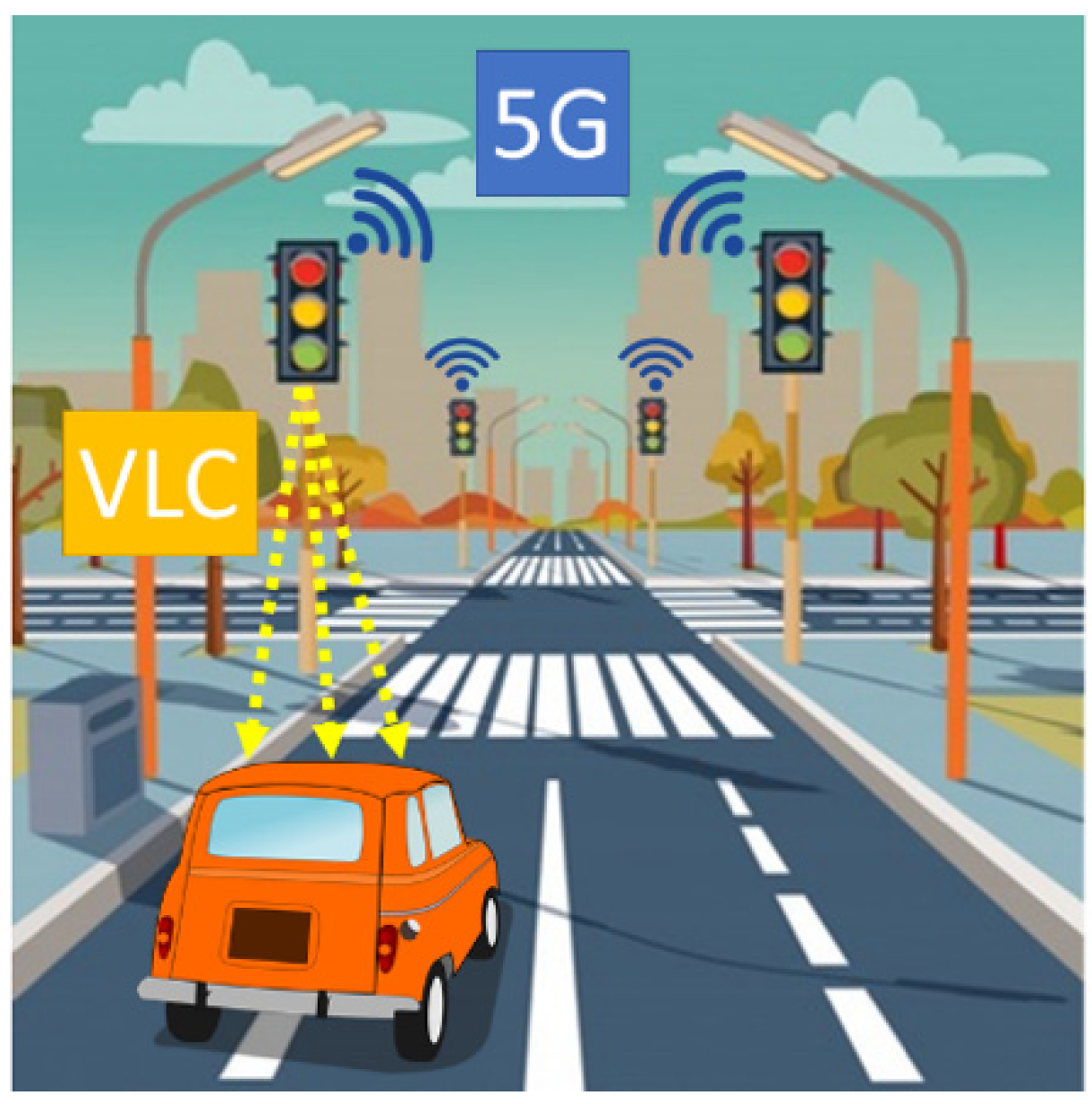

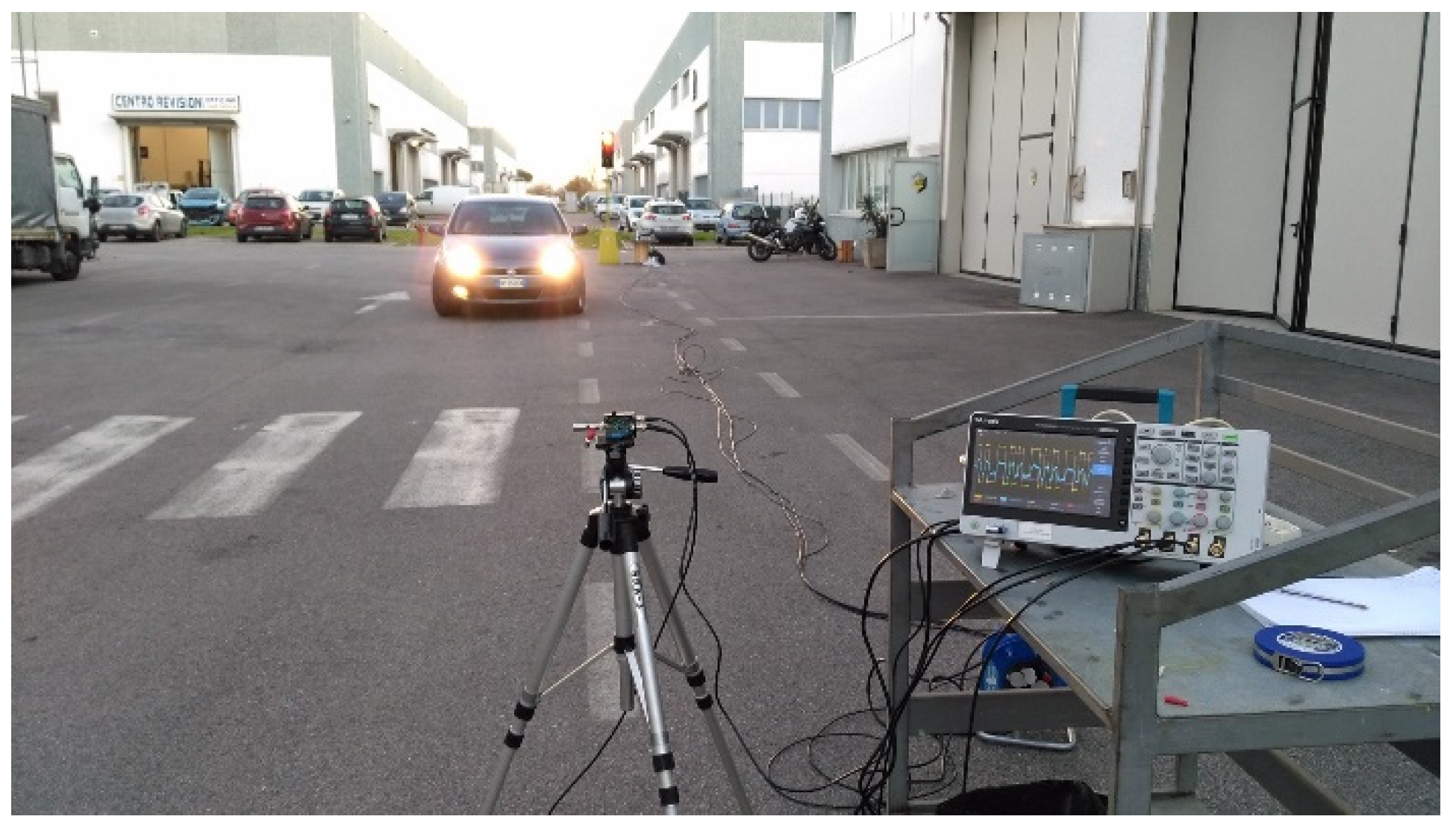
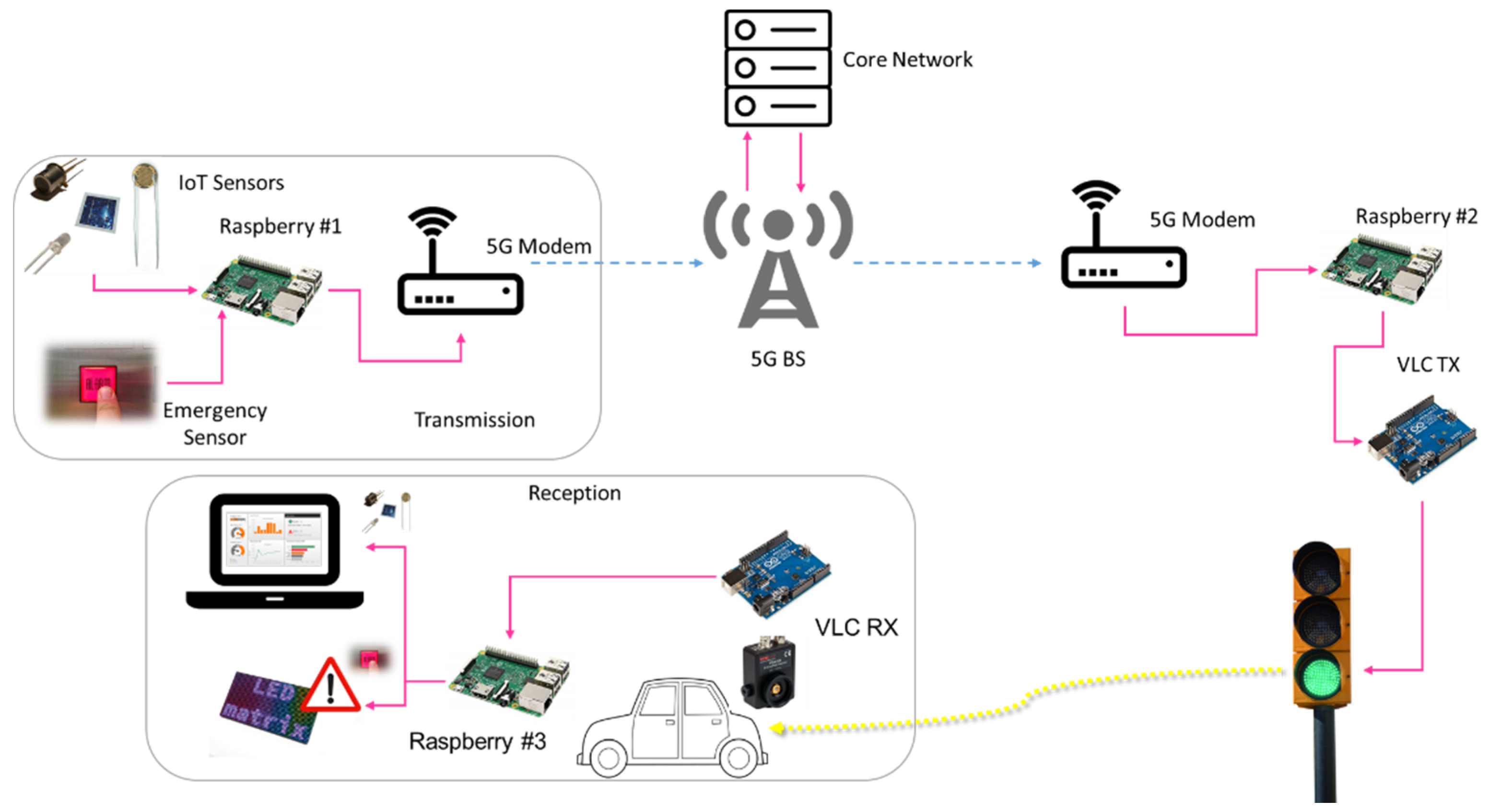


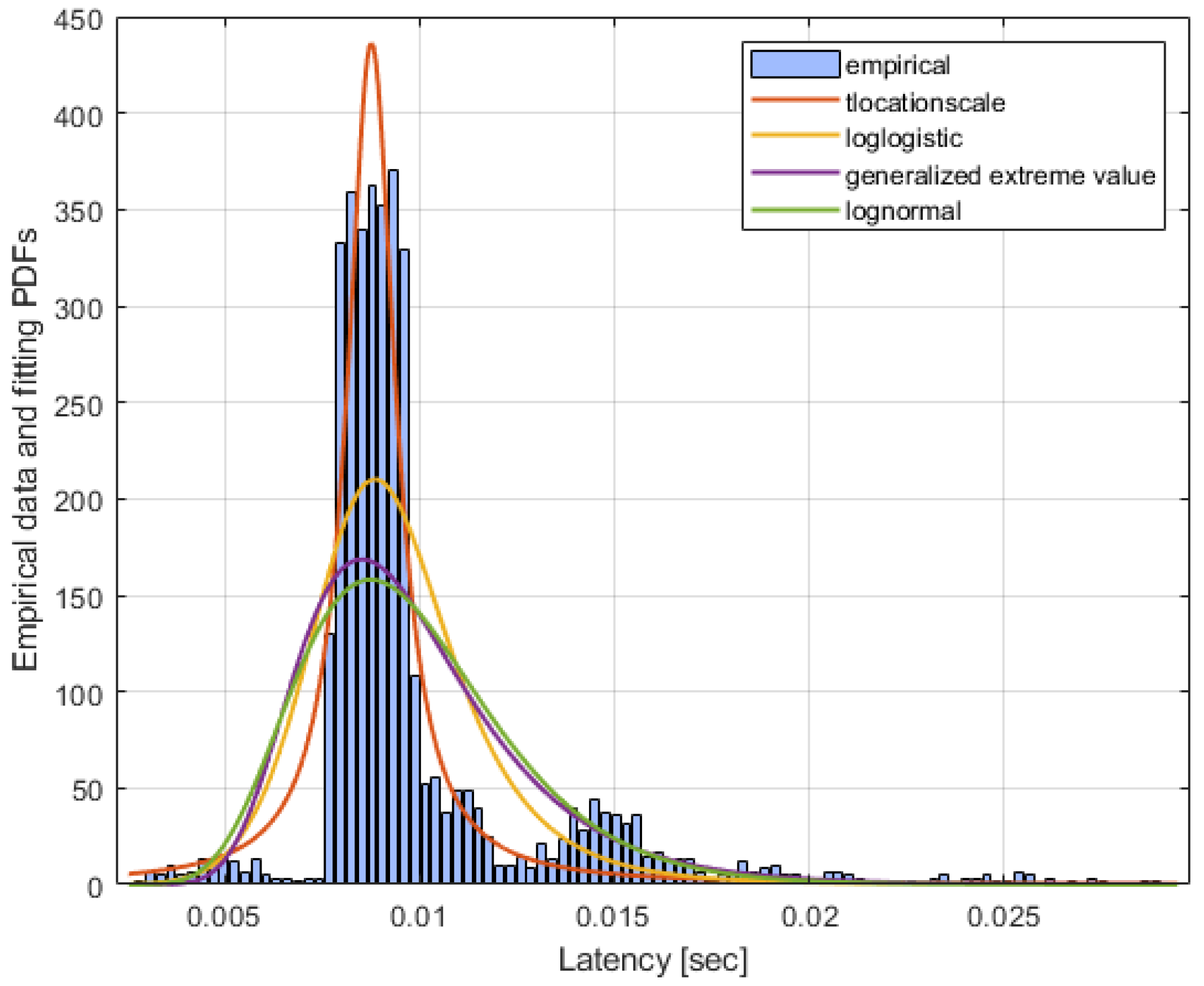


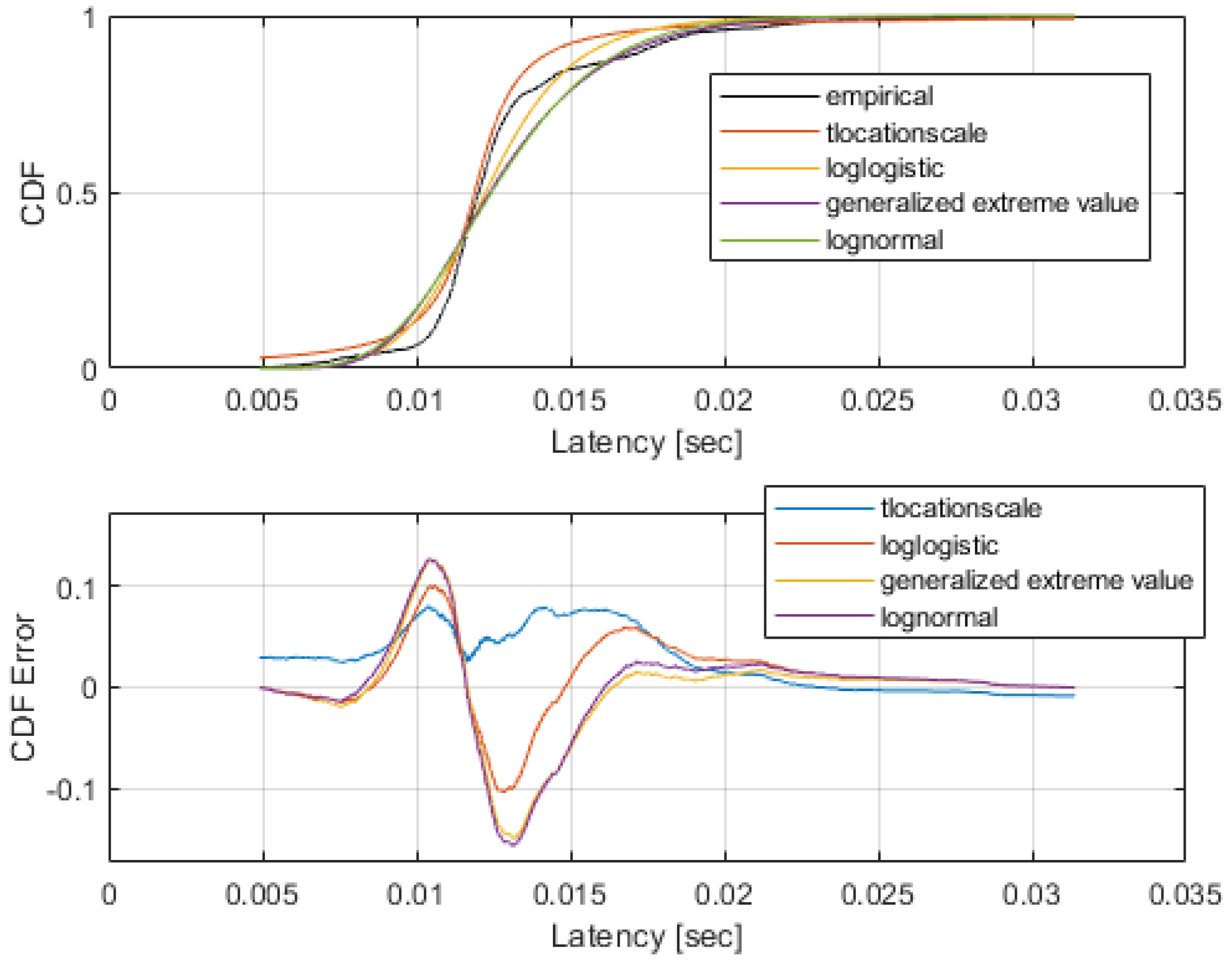
| Use Case | Description |
|---|---|
| e-Health | A platform that provides personalized care and assistance with guaranteed quality of service and continuity for telemedicine, telemonitoring and analysis of behavioural habits. |
| Smart industry | A digital platform to provide Industry 4.0 services for the optimization of production processes, energy efficiency, maintenance and operation. |
| Smart grid | A management architecture inspired by blockchain protocol enabling new services and management methods of the load and generation assets. |
| IoT and sensors | Connected sensors (following the IoT paradigm) for real-time remote control of the industrial processes, heavy machinery in hazardous environments, logistics optimization and products tracking. |
| Structural health monitoring | A monitoring service for buildings/infrastructures, reporting any anomaly of the most significant structural parameters even in emergency (e.g., earthquake) by means the use of sensors and drones. |
| Virtual reality for cultural heritage | An immersive virtual visit of different type of cultural heritage with digital contents delivery by using the virtual reality and the augmented reality. |
| Agriculture 2.0 | Support and improvement of the Made in Italy brand. Tracking of products and production processes in the Agro-Food sector. |
| Technology | Latency: Best Fitting Distribution | Distribution Parameters [µ, σ, ν] |
|---|---|---|
| 5G | t-location scale | [0.0088, 7.43 × 10−4, 1.09] |
| VLC | t-location scale | [0.0119, 0.001, 1.253] |
© 2020 by the authors. Licensee MDPI, Basel, Switzerland. This article is an open access article distributed under the terms and conditions of the Creative Commons Attribution (CC BY) license (http://creativecommons.org/licenses/by/4.0/).
Share and Cite
Marabissi, D.; Mucchi, L.; Caputo, S.; Nizzi, F.; Pecorella, T.; Fantacci, R.; Nawaz, T.; Seminara, M.; Catani, J. Experimental Measurements of a Joint 5G-VLC Communication for Future Vehicular Networks. J. Sens. Actuator Netw. 2020, 9, 32. https://doi.org/10.3390/jsan9030032
Marabissi D, Mucchi L, Caputo S, Nizzi F, Pecorella T, Fantacci R, Nawaz T, Seminara M, Catani J. Experimental Measurements of a Joint 5G-VLC Communication for Future Vehicular Networks. Journal of Sensor and Actuator Networks. 2020; 9(3):32. https://doi.org/10.3390/jsan9030032
Chicago/Turabian StyleMarabissi, Dania, Lorenzo Mucchi, Stefano Caputo, Francesca Nizzi, Tommaso Pecorella, Romano Fantacci, Tassadaq Nawaz, Marco Seminara, and Jacopo Catani. 2020. "Experimental Measurements of a Joint 5G-VLC Communication for Future Vehicular Networks" Journal of Sensor and Actuator Networks 9, no. 3: 32. https://doi.org/10.3390/jsan9030032
APA StyleMarabissi, D., Mucchi, L., Caputo, S., Nizzi, F., Pecorella, T., Fantacci, R., Nawaz, T., Seminara, M., & Catani, J. (2020). Experimental Measurements of a Joint 5G-VLC Communication for Future Vehicular Networks. Journal of Sensor and Actuator Networks, 9(3), 32. https://doi.org/10.3390/jsan9030032










